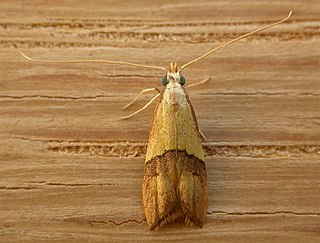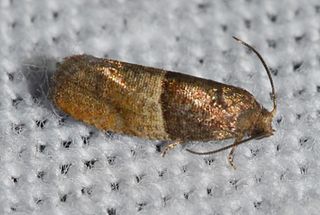Related Research Articles

The Tortricidae are a family of moths, commonly known as tortrix moths or leafroller moths, in the order Lepidoptera. This large family has over 10,350 species described, and is the sole member of the superfamily Tortricoidea, although the genus Heliocosma is sometimes placed within this superfamily. Many of these are economically important pests. Olethreutidae is a junior synonym. The typical resting posture is with the wings folded back, producing a rather rounded profile.

Crocanthes prasinopis is a species of moth of the family Lecithoceridae. It is found in most Australia and New Guinea.

Eudocima phalonia, the common fruit-piercing moth, is a fruit piercing moth of the family Erebidae. The species was first described by Carl Linnaeus in his 1763 Centuria Insectorum. It is found in large parts of the tropics, mainly in Asia, Africa and Australia but introduced into other areas such as Hawaii, New Zealand and the Society Islands. It is one of major fruit pests in the world.

Larisa is a genus of moths belonging to the subfamily Olethreutinae of the family Tortricidae. It contains only one species, Larisa subsolana, which is found in North America, where it has been recorded from Alabama, Florida, Georgia, Illinois, Indiana, Kentucky, Maine, Maryland, Massachusetts, Minnesota, Mississippi, Missouri, New York, Ohio, Oklahoma, Ontario, Quebec, South Carolina, Tennessee, Texas, Virginia and West Virginia.
Cryptophlebia ombrodelta, the litchi fruit moth or macadamia nut borer, is a moth of the family Tortricidae. The species was first described by Oswald Bertram Lower in 1898. It is native to India, Sri Lanka, Nepal, Indonesia, China, Taiwan, Vietnam, Thailand, western Malaysia, New Guinea, the Philippines, Japan, Guam, the Caroline Islands, Australia and has been introduced to Hawaii.

Planotortrix excessana, the greenheaded leafroller, is a moth of the family Tortricidae. It is native to New Zealand and is an introduced species in Hawaii. It is extremely variable in appearance and feeds on many native and introduced species. It is regarded as a pest of some agricultural and forestry crops.

Cochylichroa hospes, the banded sunflower moth, is a moth of the family Tortricidae. It is found from North Carolina to Colorado, Utah, New Mexico and northern Arizona.

Sparganocosma is a genus of moths in the family Tortricidae. It contains only one species, Sparganocosma docsturnerorum, which is found in north-western Costa Rica.
Eupinivora ponderosae is a species of moth of the family Tortricidae. It is found in the montane regions of the western United States from Nevada, Utah, Wyoming and Colorado, south to Arizona and New Mexico and east to Texas. The habitat consists of conifer-dominated areas at elevations ranging from 1,700 to 2,700 meters.
Eupinivora albolineana is a species of moth of the family Tortricidae. It is found in mountains of Durango in Mexico.
Asthenoptycha heminipha is a species of moth of the family Tortricidae. It is found in Australia, where it has been recorded from Queensland.
Statherotis euryphaea is a species of moth of the family Tortricidae. It is found in Australia, where it has been recorded from Queensland and New South Wales.
Epiphyas erysibodes is a species of moth of the family Tortricidae. It is found in Australia, where it has been recorded from New South Wales and Tasmania. The habitat consists of open forests.
Bactra testudinea is a species of moth of the family Tortricidae. It is found in Australia, where it has been recorded from Queensland.
Holocola phaeoscia is a species of moth of the family Tortricidae. It is found in Australia, where it has been recorded from Queensland and New South Wales.
Epinotia absconditana is a species of moth of the family Tortricidae. It is found in Australia, where it has been recorded from New South Wales and Queensland.
Lozotaenia kumatai is a species of moth of the family Tortricidae. It is found in Japan on the island of Hokkaido.

Apoctena orthocopa is a species of moth of the family Tortricidae. It is endemic to New Zealand, where it is found only on the North Island.

Spatalistis christophana is a species of moth of the family Tortricidae. It is found in Taiwan, China, Korea, the Russian Far East and Japan.
Rectiostoma flinti is a moth in the family Depressariidae. It was described by W. Donald Duckworth in 1971. It is found in Mexico.
References
| Wikispecies has information related to Melanodaedala scopulosana |
| Wikimedia Commons has media related to Melanodaedala scopulosana . |
| This Eucosmini-related article is a stub. You can help Wikipedia by expanding it. |